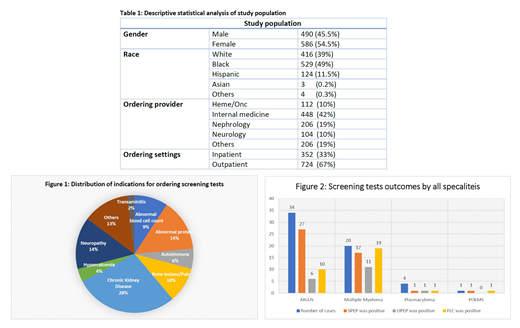Background.
Plasma cell Dyscrasias (PCD) are a spectrum of monoclonal gammopathies which result from proliferation of plasma cells that produce an immunologically homogeneous protein known as M-protein. PCDs include monoclonal gammopathy of undetermined significance (MGUS), smoldering multiple myeloma (SMM), multiple myeloma (MM), Waldenstrom's macroglobulinemia (WM), primary amyloidosis (AL), plasmacytoma, light chain deposition disease (LCDD) and POEMS syndrome. Screening for gammopathy is usually done by serum protein electrophoresis (SPEP) with immunofixation (IFE), serum free light chains (FLC) and urine protein electrophoresis (UPEP) with immunofixation. Except for low risk MGUS, early diagnosis can have a significant impact on the clinical outcome of PCD. Thus, accurate and timely screening for early diagnosis is crucial. In this study, we aim to evaluate the screening process for plasma cell dyscrasias in a teaching hospital by targeting internal medicine physicians including primary care physicians.
Methods:
We retrospectively reviewed charts of 2532 patients who had undergone PCD screening tests at Truman Medical Center (TMC), the primary teaching hospital for University of Missouri-Kansas City (UMKC). The studied data was from two blocks of time: 2011-2012 and 2017-2018. Only patients who were >18 years of age and who had any of these screening tests done for the very first time during the study period were included. Patients who had tests done outside of the study period or had prior similar testing or known diagnosis of PCD were excluded. Data was collected to assess if screening tests had been ordered appropriately by internal medicine physicians. Appropriate screening was defined as a screening that had SPEP along with IFE and FLC. We compared internal medicine physicians' utilization of these tests between two different time frames 1/1/2011-12/31/2012 versus 1/1/2017-12/31/2018.
Results:
A total of 2532 patients were reviewed. 1076 were included with a mean age of 57.4 years. Population demographic is detailed in Table 1. Most of the PCD screening tests were ordered in the outpatient setting (67%). The three most common indications for testing were workup of chronic kidney disease, abnormal serum protein levels and neuropathy (Figure 1). Outcomes of screening tests are shown in Figure 2. Majority of these tests were ordered by internal medicine physicians (42%) followed by nephrology (19%) and hematology-oncology services (10%). Internal medicine ordered 448 tests overall. During 2011-2012 they screened 211 patients. Out of these, 199 had SPEP, 19 had IFE, 68 had UPEP and 23 patients had FLC ordered on initial screening. Only 18 patients (8.5%) were screened appropriately. Between 2017-2018, a total of 237 patients were screened by internal medicine physicians. Among them 231 had SPEP, IFE was checked by automatic reflex (a new feature added by our lab in 2013) in 138 patients, UPEP was ordered 67 times and 48 patients had FLC checked with 45 patients (19%) screened appropriately.
Conclusion:
Screening for plasma cell dyscrasias is frequently done by physicians from specialties other than hematology-oncology. Ordering an appropriate set of tests including FLC in addition to SPEP with IFE is imperative at time of initial screening. Our study showed that internal medicine physicians order most of the intial testing for PCD, however they often miss incorporating FLC as part of their screening for PCD. This could potentially lead to missing some cases and delay in timely diagnosis. Although there has been improvement in ordering appropriate screening, but proper measures should be undertaken to increase the efficacy of screening for PCD.
No relevant conflicts of interest to declare.
Author notes
Asterisk with author names denotes non-ASH members.


This feature is available to Subscribers Only
Sign In or Create an Account Close Modal